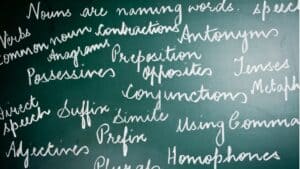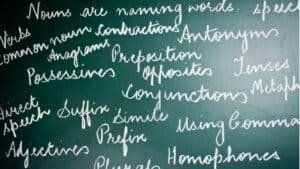
If you’re of a certain age, perhaps you learned cursive writing, also known as script, a way of writing that’s almost extinct. It’s not being taught in most schools anymore, something I find disappointing. I love my cursive writing because I find it so much faster.
When I have to fill out forms that instruct me to “please print neatly” I find it slow and tedious. I know I could write it out very clearly and much faster – my handwriting is quite nice, the result of a parochial school education and hours of practicing the Palmer method.
What is Cursive Writing?
Perhaps you don’t even know what cursive writing is? It’s astyle of penmanship that joins the letters together so that one writes in a continuous, flowing way, not lifting the pen from the paper after each letter. It’s very functional, used for ordinary daily writing as well as in calligraphy.
When I was a child, it was the universal way one wrote. In school, we spent hours practicing the Palmer method, making continuous circles that looked like a long slinky, or continuous spike-like strokes that looked like Donald Trump’s signature or an EKG. We were taught to move our arm from the elbow to the fingertips, in a gliding motion, rather than just the hand. It was fun!
I never thought of cursive writing as anything special. It was just the way I wrote, as did all my peers. And it never occurred to me that discontinuing it would have ramifications – but it does!
If You Can’t Write It, You Can’t Read It
For one thing, if you never learn how to write cursive, you can’t read it! I found this out when I left my grandson a note one day when I went out – “Gone to the store. Back soon.”
When I got home, he asked me where I had gone, and I said, “Didn’t you see my note?”, to which he replied, “I did, Granny, but I don’t know how to read cursive.” I knew it wasn’t being taught anymore, but it never occurred to me that this meant young people couldn’t read it.
Historical Documents
So, where does that leave the Declaration of Independence? When Thomas Jefferson drafted the document before the American colonies declared their independence from Great Britain, he joined most but not all the letters.
However, a few days later, it was rewritten in the fully joined, “proper” cursive style we see on display now. Think of John Hancock’s beautiful large scroll, written large and first so that Britain’s King George could “read it without spectacles.” Would it be the same in printed block letters???
What About Signatures?
Which brings up signatures. For generations, our signature has been an indicator of our authenticity, analyzed by handwriting experts to determine if it’s genuine. Can you do that with print?
Often, we’re asked to sign below and print our name beneath it. Is a printed signature legal? Can experts tell if it’s genuine? My research tells me that not only are printed signatures legal, but even something like a smiley face can be! Good grief! Remember when illiterate people made their X?
Apparently, cursive is making a return to school curriculums in the United States. One of the things holding it up is the lack of teachers who know it and know how to teach it.
Handwriting in all forms will probably disappear completely someday, now that we’ve entered the era of typing on a computer or pecking out messages in texts. But personally, I hope that cursive returns.
How do you feel about it? Is it being taught in your school districts? Can your children and grandchildren read cursive? Can you share a story where your handwritten note could not be deciphered? Let have a laugh together!





